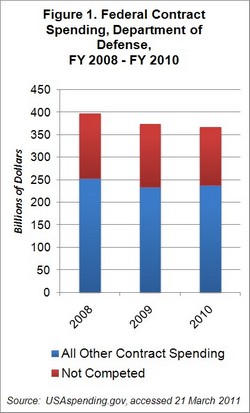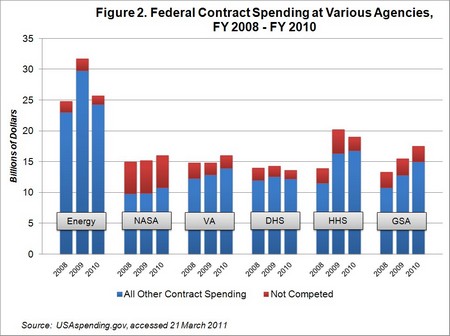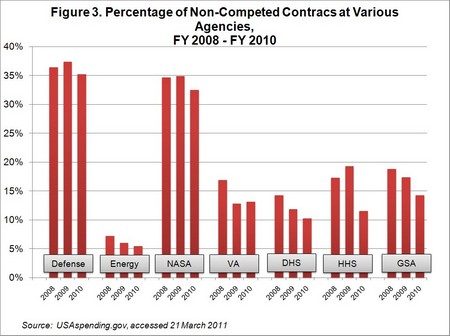
Non-Competed Contracts Down Slightly in FY 2010
3/22/2011
In February, the Inspector General (IG) of the Department of Homeland Security (DHS) completed an audit examining the agency's use of non-competed contracts in fiscal year (FY) 2010. The audit finds DHS significantly reduced its use of these risky contracting vehicles, lowering both the total real contracting dollars spent and the percentage of contracting dollars spent on sole-source contracts. An examination of other federal agencies' non-competed contract spending reveals a similar, though less dramatic, trend.
A March 7 Government Executive article trumpeted the IG audit, announcing, "DHS awards fewest noncompetitive contracts ever." The piece went on to relay that the agency obligated $1.3 billion in non-competed contracts in FY 2010, making up roughly 10 percent of DHS's contract spending. This total is down from $3.4 billion in FY 2009 and $3.5 billion in FY 2008, which made up 24 and 25 percent of the agency's yearly contract spending, respectively.
DHS IG personnel made use of the federal government's Federal Procurement Data System (FPDS) to aggregate their totals, but one can make a rough approximation of the results through USAspending.gov, which uses data from FPDS.
A small group of federal agencies spends the vast majority of federal contracting dollars each year and is a good representation of how the government spends taxpayer funds on contracting. The Department of Defense (DOD) is the largest spender in this group, making up approximately 70 percent of the government's yearly contract obligations.
Together, the Departments of Energy, Veterans Affairs (VA), and Health and Human Services (HHS), along with the National Aeronautics and Space Administration (NASA), the General Services Administration (GSA), and DHS, make up another 20 percent, on average, each year. The other 10 percent of the government's contract dollars are spread over dozens of other departments and programs.
Looking at the seven agencies listed above, and combining only those contract totals listed under "not competed" and "not available for competition" in USAspending.gov, a rough pattern of reduced use of sole-source contracts similar to DHS's experience emerges.


Figures 1 and 2 show total contracting dollars and total non-competed contracting dollars spent by the seven agencies over the course of FY 2008 to FY 2010. Figure 3 shows those non-competed contracting dollars as a percent of total contracting dollars spent over that same period.

As can be seen in Figure 3, non-competed contract awards are decreasing as a percentage of total contract spending, yet they remain high at DOD and NASA, with both agencies averaging in the mid-thirties.
Some agencies, however, have seen significant reductions similar to DHS: HHS (Fig. 3) reduced sole-source contract totals from 17 percent of all contract spending in FY 2008 to 11 percent in FY 2010, and GSA (Fig. 3) reduced non-competed contract totals from 19 percent to 14 percent over the same period. Similarly, the VA (Fig. 3) saw a four percent reduction between FY 2008 and FY 2010. The Department of Energy, which is perennially the second leading spender of federal contracting dollars (Fig. 2), witnessed a less significant reduction, with non-competed contract spending reduced by only about two percent (Fig. 3).
When the Obama administration released its original contracting reform memorandum back in March 2009, the president specifically targeted the use of non-competed contracts:
Excessive reliance by executive agencies on sole-source contracts ... creates a risk that taxpayer funds will be spent on contracts that are wasteful, inefficient, subject to misuse, or otherwise not well designed to serve the needs of the Federal Government [sic] or the interests of the American taxpayer.
The Office of Management and Budget (OMB) followed up with several sets of guidance released in July and October 2009. The July guidance instructed agencies to carry out two immediate tasks: reduce contract spending by seven percent by the end of FY 2011 and reduce the total use of high-risk contract vehicles, such as non-competed contracts, but also including cost-reimbursement, time-and-materials (T&M), and labor-hour (LH) contracts, by 10 percent in FY 2010. The October guidance provided broad guidelines for federal agencies that would allow them to continue the reductions sought in July.
Based on USAspending.gov data, most federal agencies are moving in the right direction. Even as many agencies' budgets have increased over the last three fiscal years, department heads have generally been able to keep the share of sole-source contract spending low, and some have even been able to decrease it as total contract spending grew. Only time will tell if these non-competed contracting figures continue to go down and whether the Obama administration can stick to its promise of reforming federal contracting and reducing taxpayer dollars used in risky contracting vehicles.


